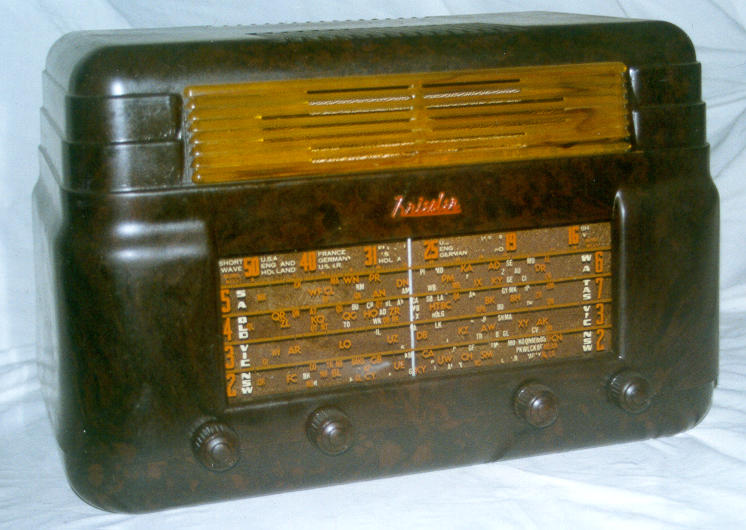
The controls are: Tone, Volume ON/OFF, Tuning, and Wave change. It has a serial number of 24242 (and another number of 070596). It does have a sticker inside that may be an ARTS&P sticker, but it is so faded that no lettering or the colour can be determined. The speaker is mounted in the top, facing upwards and slightly angled towards the front. The sound can exit through the yellow front grill and the top louvers. The badge has the upper stroke missing from the letter K. There are no cracks except for the repair to the 2 rear louvres.
There were two models of this radio. The 11-7 was made in 1947, and the 11-7/11-9 (Amended) was made in 1948. They looked the same externally, except for the dial glass, which had the Short Wave band at the bottom on the earlier one, and at the top on the later one. The valve line up was different. The earlier model has an 6X5GT rectifier, a 6V6GT audio output, 6B6G audio preamplifier, AVC and detector, 6U7 IF amplifier, and ECH35 mixer. The later model has a 6X5GT rectifier an EL33A audio output, 6SQ7 audio preamplifier, AVC and detector, 6SK7GT IF amplifier, and ECH35 mixer.
The one I have is slightly different again. The valves used are: 5Y3 rectifier, EL33A audio output, 6SQ7 audio preamplifier, AVC and detector, 6SK7 IF amplifier, and 6A8 mixer. All the valves are GT except for the EL33A.
The radio was swapped for some junk from my dads garage to an Old Wares shop, located in Tea Gardens NSW. It was in a very bad condition. The case was dull and powdery, with 2 broken louvers on the back, through which mice had entered. They had eaten through the speaker cloth and the speaker cone to enter the main part of the radio. There they had nibbled on a few capacitors and eaten through several wires.
The wires were replaced, all the capacitors renewed, and new pilot lights installed. The dial cord was renewed together with the mains cord. The speaker baffle had sagged, so it was renewed and a new speaker fitted. The tone control is a 3 position switch, and this was broken off and the shaft and knob were missing. A new shaft was made and a matching knob purchased from a radio restoration shop in Newtown in Sydney. Luckily the broken louvers had fallen inside the case, so I glued them back in place. I polished and oiled the bakelite case with Linseed Oil till it was shiny again. All the valves were good. The set was realigned and works well.

HISTORY OF THE KRIESLER COMPANY
Alec, Leo and Rae Weingott established and registered their company as The Kriesler Radio Company in Alice Street, Newtown, Sydney. They did intend it to be KREISLER, involving the name of Fritz Kreisler the composer and violin virtuoso but changed the spelling to avoid any legal problems. By 1933 the company had been operating for some five years, having concentrated upon the manufacture of stencil lines for music houses, such as Elvy's and Palings. The company was in trouble and liquidation seemed unavoidable. Kriesler was, by this time, one of the 243 registered radio manufacturers in Australia.
An investor, Percy Tuit who had made his money from a hosiery wholesaling business, offered to buy the about to be liquidated Kriesler Radio Company, and loaned the youngest Weingott (Rae) sufficient capital to take up a 49% interest. Kriesler continued to make stencil brands, but realised its own brand name was worth concentrating upon and did so.
Rae Weingott had flair. To see him present a new season's range of products at the Trocadero or old Wentworth Hotel, was an experience never to be forgotten. He was the master of the remotely controlled "magic lantern" and "voice over" techniques, well before it was used by others. One would believe he was presenting a new season's range of motor vehicles, not mere radios.
Kriesler made a great contribution to Australia's 1939-1945 war effort, as the special Mingay's edition commemorating the effort of the Australian radio makers will testify. After the war, Kriesler put to good use its special "put aside" advertising account and that, plus inspirational phrases from Rae Weingott, such as: "Mirrorscopic Tuning", "Triple Throat", and those "Three Little Words - Kriesler Triple Throat"; resulted in Kriesler being ranked third in Australia's radio manufacturers prior to the advent of television in Australia in 1956.
Perce and Rae sold Kriesler to Philips in about 1950 because they did not have the money to go into television without going public. They also believed their loyal staff worthy of care and what they did was best for them. The rationalisation of the Australian radio industry after 1973 included, in due course, the demise of the truly Australian Kriesler Radio brand name. The Caringbah - Sydney factory was closed in 1982 and the KRIESLER brand left the Australian market 31st December 1983.
REFERENCES
THE KRIESLER STORY, Fred Lane. Radio Waves Number 38, October 1991.
11-7 circuit
11-7/11-9 circuit
11-7/11-9 parts list
Copyright
Ray Robinson